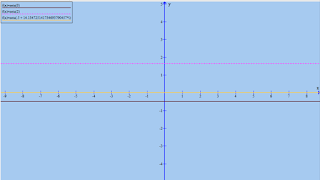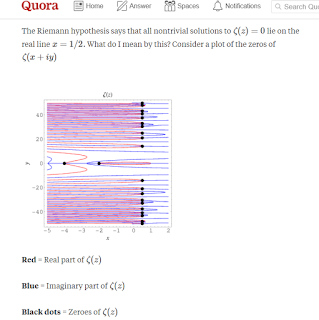Sunday, June 30, 2019
The Difference
The Euler zeta function is for real numbers. And the Riemann
zeta does extend to the complex plane. (One needs to be careful
with zeta calculators):
zeta does extend to the complex plane. (One needs to be careful
with zeta calculators):
As expected, it is -.5 at 0, undefined at 1, and works fine at real 2.
Below, Grapher handles both real and complex.
Saturday, June 29, 2019
Clear
Need to get clear on when and where to zeroes might appear.
cos(x) is at .5 at 60 degrees, or 1.047 rad. The value of sin(x)
will be .8660 at that point. Greater than 1 values means we are
on a larger than unit-1 circle, but the proportions are the same.
So what is the situation here: the value of zeta is controlled by that of s.
Anything to the power of 0 clocks in at 1. In a function that oscllates between
zero and 1, those1s will settle to a global 0.
The oscillator is 1 at 0, and the numbers to the right conspire to an odd.
(try n=4).
cos(x) is at .5 at 60 degrees, or 1.047 rad. The value of sin(x)
will be .8660 at that point. Greater than 1 values means we are
on a larger than unit-1 circle, but the proportions are the same.
So what is the situation here: the value of zeta is controlled by that of s.
Anything to the power of 0 clocks in at 1. In a function that oscllates between
zero and 1, those1s will settle to a global 0.
The oscillator is 1 at 0, and the numbers to the right conspire to an odd.
(try n=4).
Friday, June 28, 2019
TheR
It is Bernard Riemann - student of Gauss - who rescued
the Euler identity between an additive and power series to create
what he called the Zeta function. Trying to appreciate how this what
put together.
The first term looks friendly enough, and gives a multiplicative.
The (s-1) exponent quickly gives finer terms.
the Euler identity between an additive and power series to create
what he called the Zeta function. Trying to appreciate how this what
put together.
The first term looks friendly enough, and gives a multiplicative.
The (s-1) exponent quickly gives finer terms.
So for Zeta(3), one gets 4/3
For Z(4), it is not 5/4:
Seven is the fourth prime.
* * *
Stuck on 2.
Oscillates between zero and 1. Next two items are in service of
making sure a zero appears where required...
Bloats the numbers.
A fraction with the value of s.
All in all, informative for extended cases, s as fractions, negative fractions, complex
numbers...
Try with s = .5; n=200; a modest k.
Thursday, June 27, 2019
Easy
I took a Calculus course in university many years ago,
and the experience was so mind-bending I had anxiety
dreams about it years later. Till I finally decided as an
adult to go back and rework a ton of problems, and find
some closure with all that...
Complex exponents, I can do this. The central idea is that one
can go to Euler's notion that z(a real number plus an imginary one)
can be expressed as trigonometric functions. Easy!
https://www.dcode.fr/complex-number-exponential-form
4 + 64 = 68
8/2 = 4
https://sites.math.washington.edu/~marshall/math_307/complexnos.pdf
https://www.mathsisfun.com/numbers/complex-number-calculator.html
and the experience was so mind-bending I had anxiety
dreams about it years later. Till I finally decided as an
adult to go back and rework a ton of problems, and find
some closure with all that...
Complex exponents, I can do this. The central idea is that one
can go to Euler's notion that z(a real number plus an imginary one)
can be expressed as trigonometric functions. Easy!
https://www.dcode.fr/complex-number-exponential-form
4 + 64 = 68
8/2 = 4
https://sites.math.washington.edu/~marshall/math_307/complexnos.pdf
https://www.mathsisfun.com/numbers/complex-number-calculator.html
* * *
Keeping in mind one can go to base e easily enough by
adding ln(current base number) to any expression with an exponent:
* * *
Wednesday, June 26, 2019
Signs
The computation of the Riemann zeta function involves knowing
more than the identities on which it rests. In effect, the zeroes in
question are those that appear for S on the real line! As one person put it in
a forum: Computing the Riemann zeta function is an entire new branch
of mathematics.
Riemann was a student of Dirichlet's; we owe him the modern definition of
the function as a single-valued correspondance between domain and range.
Dirichlet also opened the study of L-functions, of which the Riemann zeta
is the simplest expression.
http://www.lmfdb.org/
Below, a look at sign changes:
more than the identities on which it rests. In effect, the zeroes in
question are those that appear for S on the real line! As one person put it in
a forum: Computing the Riemann zeta function is an entire new branch
of mathematics.
Riemann was a student of Dirichlet's; we owe him the modern definition of
the function as a single-valued correspondance between domain and range.
Dirichlet also opened the study of L-functions, of which the Riemann zeta
is the simplest expression.
http://www.lmfdb.org/
Below, a look at sign changes:
* * *
As for why the Geogebra numbers move the way they do...tomorrow!
I'll be starting here:
source: Sciencedirect
Monday, June 24, 2019
PCounting
Getting clear about where the Riemann hypothesis resides in mathematics,
the Prime Number Theorem - which has been proven - asserts that
eventually, the number of primes will be N/ln(N). This is an analytical
statement. The Riemann hypotheses is part if the more practical prime-counting
function, seeking to estimate the number of primes up to a certain value.
source: Wikipedia
As for 'nailing' where all the primes might be, we are at the heart of the
difficulty: the only way to find them is to enumerate their description !😂
Sunday, June 23, 2019
FBloat
A doughnut shop is not a home; and conversely, a home is
not a doughnut shop. Eac can offer feelings of well-being, but
they are not the same. This profound truth is also something to
keep in mind in decisional moments, such as elections. There
are kicks to be had, it is true, but the codes are different. I
will turbo-charge the economy can well mean higher taxes for
the less well-off, and an easy Brexit can become no strawberries.
America is also easing into an election. A great populist moment
across the spectrum, because America is large and diverse, and
the political aspirants get to crowd-bathe and spread good humour.
Would I believe any of it? The warnings of one on the, perhaps. Washington
is a machine, and the strangest things like budget seizures of impeachment
enquires can be set off any ol' time. Odd!
A Titanic battle is apparently raging in the European Community about who
should lead the Commission for the next mandate: Germany's Head of List
with little experience but the rightful heir, or France's Michel Barnier for his
drop-dead performance on Brexit. Nobody got that the UK needs help on the
festering Irish situation, fish-tail to centuries of religious wars in Europe.
Here in Quebec, it is the National Holiday Week-End (poor thing loss
it's name to political rectitude). Going further, the City of St-Jean-sur-
Richelieu has not seen fit to publish a calendar of events or a Web site,
just a notice of street closures on given dates. Looking forward to next
week-end's Canada Day traffic disruptions.
And in the spirit of all this, Livia - a fitness girlfiend - has posted a
rather interesting video on face bloat after a day of eating doughnuts.
Do enjoy!
not a doughnut shop. Eac can offer feelings of well-being, but
they are not the same. This profound truth is also something to
keep in mind in decisional moments, such as elections. There
are kicks to be had, it is true, but the codes are different. I
will turbo-charge the economy can well mean higher taxes for
the less well-off, and an easy Brexit can become no strawberries.
America is also easing into an election. A great populist moment
across the spectrum, because America is large and diverse, and
the political aspirants get to crowd-bathe and spread good humour.
Would I believe any of it? The warnings of one on the, perhaps. Washington
is a machine, and the strangest things like budget seizures of impeachment
enquires can be set off any ol' time. Odd!
A Titanic battle is apparently raging in the European Community about who
should lead the Commission for the next mandate: Germany's Head of List
with little experience but the rightful heir, or France's Michel Barnier for his
drop-dead performance on Brexit. Nobody got that the UK needs help on the
festering Irish situation, fish-tail to centuries of religious wars in Europe.
Here in Quebec, it is the National Holiday Week-End (poor thing loss
it's name to political rectitude). Going further, the City of St-Jean-sur-
Richelieu has not seen fit to publish a calendar of events or a Web site,
just a notice of street closures on given dates. Looking forward to next
week-end's Canada Day traffic disruptions.
And in the spirit of all this, Livia - a fitness girlfiend - has posted a
rather interesting video on face bloat after a day of eating doughnuts.
Do enjoy!
Saturday, June 22, 2019
The Sub
Finally understood how the derivative of the natural logarithm
gets one a fraction.
This means that the Omega constant is the unique value where
the derivative on an e value is equal to the derived.
It also reminds us that e^0 = 1, and that this substitution might prove useful.
gets one a fraction.
This means that the Omega constant is the unique value where
the derivative on an e value is equal to the derived.
It also reminds us that e^0 = 1, and that this substitution might prove useful.
Friday, June 21, 2019
Zero
Asked Grapher to calculate with complex numbers,
in the graph settings. The true result shows up in
evaluate, but one only sees a graph if the result is real:
source: Wikipedia, Simple English
in the graph settings. The true result shows up in
evaluate, but one only sees a graph if the result is real:
FirstDay
First day of summer. Colder than normal, as this
Spring has been for us.
Thinking of our gorl, struggling with her weight. So what gives
with perfect thin girls vs the fat girl with the 'abnormally' pretty
face. There's a math problem there, lurking... Call me crazy, but
maybe the perfect ones...
Happy Summer, 2019!
* * *
And for those following my adventures in Mathematics,
a German-language video on Einstein's Feld equations,
alluding to the situation being described:
Spring has been for us.
Thinking of our gorl, struggling with her weight. So what gives
with perfect thin girls vs the fat girl with the 'abnormally' pretty
face. There's a math problem there, lurking... Call me crazy, but
maybe the perfect ones...
Happy Summer, 2019!
* * *
And for those following my adventures in Mathematics,
a German-language video on Einstein's Feld equations,
alluding to the situation being described:
Thursday, June 20, 2019
New Num
I think I've reached a new planet. There I was musing
about what integrating fractional expressions does.
One ends up a situation where the integral can no
longer be used for reading the value of the original
function. At its simplest:
Out of curiosity, wanted to see where my two curves meet.
Only Wolfram would tell me, and I've stumbled upon a brand
new trancendental number, W, a Lambert number.
They meet at 1.763...
Rather close to the square root of pi, in fact!
about what integrating fractional expressions does.
One ends up a situation where the integral can no
longer be used for reading the value of the original
function. At its simplest:
Out of curiosity, wanted to see where my two curves meet.
Only Wolfram would tell me, and I've stumbled upon a brand
new trancendental number, W, a Lambert number.
They meet at 1.763...
Rather close to the square root of pi, in fact!
So this is a unique value, where e^this value is equal to 1/this value:
How is this value arrived at?
Wednesday, June 19, 2019
Not C
The factorial function has to start at 1, and requires dots
or lines. It is not continuous!
Checking our use of the function to find various factorials:
So, everything works!! And it is just a matter of plugging in the numbers. Yet
the gamma function is considered possibly the most difficult function in all
of mathematics. No doubt because the actual solving of the integral requires
'integration by parts'. And what is the role of the e factor in all this?
aka Advanced Calculus:
* * *
The green curve is the integral to the pink:
The are area under the red is the square root of pi:
Subscribe to:
Comments (Atom)














































